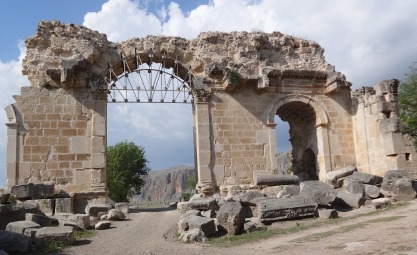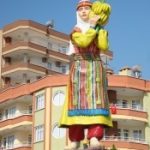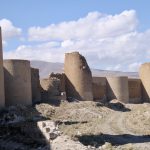Rural ruins of Caesarea-ad-Anazarbus Population: Less than 2000
The ruins of the old Roman Caesarea-ad-Anazarbus lie scattered about the small village of Ayşehoca northeast of Adana, off the road to Kozan. They are overlooked by a vast limestone plateau topped with a citadel belonging to the Armenian Kingdom of Cilicia. This flourished from 1080 to 1375 when the Mamluks drove them out; for some time this was actually the capital before first Tarsus and then Sis (Kozan) took over.
Backstory
This is a crossroads corner of Turkey which has been traversed by a confusing succession of players. Two thousand years ago it was part of the Roman province of Cilicia, and it was the Romans who founded the city of Caesarea-ad-Anazarbus.
But as their hold on the province weakened Cilicia split into two. Tarsus became the capital of the western part and never looked back. Caesarea-ad-Anazarbus became the capital of the eastern part and was then grabbed in turn by the Persians, the Byzantines, the Arabs, the Crusaders, the Armenians and the Mamluks of Egypt. Finally, in the 15th century it was effectively abandoned.
Around the site
The ruins of Anarvarsa are 5km inland from the part of Ayşehoca that hugs the main road. As you approach the site you will come to a T-junction with a choice of whether to turn left or ight.
If you turn slightly left you will pass through a gate in the ancient city walls which, if laid end to end, would stretch for more than four km, a clue as to how important a place this forgotten town must once have been.
Inside the walls there is a vast expanse of nothingness with the castle looming over it from atop the rocky plateau. Pieces of column litter the ground and there are a few substantial remains of brick structures that were probably bathhouses. Otherwise, this is now just a large piece of pasture for local sheep and cattle.
If instead you turn right at the T-junction you’ll find a small private museum housing pieces of ancient column and a few sarcophagi (stone tombs). Its most treasured exhibit used to be a mosaic of the Roman nymph Thetis and her dolphin companions but this has now been moved into Adana Archaeological Museum.
 Past the museum the road bears to the left. Eventually you will come to the most striking relic of old Anazarbus, a triumphal arch built in honour of the Roman Emperor Septimius Severus (193-211). Scattered nearby are confusing traces of an ancient theatre, stadium and baths, as well as of a later Byzantine church. Stretches of an old Roman road have also been uncovered.
Past the museum the road bears to the left. Eventually you will come to the most striking relic of old Anazarbus, a triumphal arch built in honour of the Roman Emperor Septimius Severus (193-211). Scattered nearby are confusing traces of an ancient theatre, stadium and baths, as well as of a later Byzantine church. Stretches of an old Roman road have also been uncovered.
Keep walking and eventually you will spot Roman tombs cut into the rock. Over the centuries Anazarbus was repeatedly battered by earthquakes; a Biblical inscription in the rockface appears to refer to them.
Theoretically you can climb up to the hilltop fortress although few locals would recommend this (“snakes”, they say). If you do climb up you will find reminders of an obscure piece of medieval history. From 1080 to 1375 Anazarbus had a second flowering as part of the Armenian Kingdom of Cilicia. During those years kings with names like Rupen and Leo were buried inside the fortress and you can still inspect the walls of their church even though its frescoes grow fainter with every passing year.
But the real reward for your exertions is not so much the buildings as the outlook, for the fortress presides over a panoramic view of the Çukurova, with, if you’re lucky, the odd eagle freewheeling on the breeze beneath you a la Yaşar Kemal.
Sleeping
There is nowhere to stay in Anavarsa. The best choice of accommodation is in Adana.
Transport info
This is a site best visited by car. Otherwise public transport from Adana will only get you as far as the village of Ayşehoca, leaving a 5km, largely shadeless walk to Anavarza.



